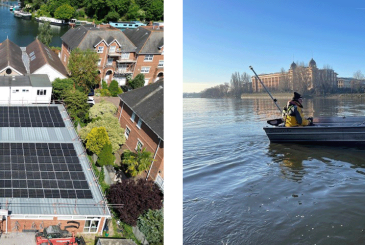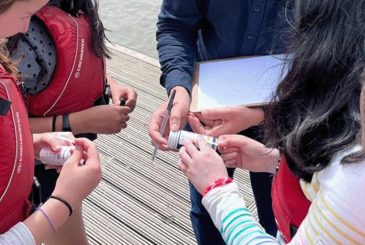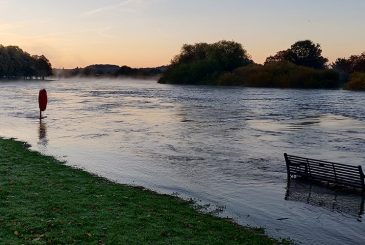Background
Prior to the Covid pandemic, Norwich-based Yare BC had been planning to develop what it could offer to the local community. Achieving this then became urgent when the club merged with Broadland BC. This approximately doubled the size of its fleet and increased its membership overnight. The Broadland boats arrived early in 2021, as soon as Covid lockdown restrictions were lifted. For the next two winters these largely lived outside, under individual covers, while plans were finalised and the work to build a new boatshed was carried out.
Today the club has about 90 members including reasonably equal proportions of former Broadland members, Yare members from before the merger and new members – some experienced and some from Learn to Row courses. It is an adults-only club, because of its location on an island; local juniors are well catered for by Norwich RC on the other side of the river, less than 1km upstream.
Designing the boatshed
The club decided that what they needed was a lightweight boatshed. This now stores singles and doubles but is long enough to accommodate eights if needed, with quads accommodated in a smaller, wooden ‘quad shed’. In terms of materials, the simple design was based on a wooden frame with a suspended wooden floor. The walls and roof used lightweight industrial metal sheeting, which was quick to install, with attractive horizontal wooden cladding on the front elevation. A club member, Nathan, who is an architect, designed and developed the proposal for the planning authority.

This choice to go for a utilitarian option was driven by several factors. Once the boats were housed in the new shed, the existing brick boathouse could be converted to a clubhouse, so there was no need to include ‘dry side’ facilities in the boatshed. Also, the club is based on an island, which is accessed by ferry dinghies. This meant that all building materials and machinery would have to be transported to the site by boat although, ingeniously, the club was able to use its floating pontoon as a ‘bridge’ or causeway across the river when a substantial amount of material needed to be delivered. Keeping it simple was particularly important.
One impact of these factors is that the boatshed does not require electric lighting. Perspex panels in the roof let in all the light that is needed for use during daylight hours. However, the club had to work hard on other design details to meet planning requirements – for example, it is located towards the back of the site so it is less visible from the river. The club also had to include a misting system in case of fire to give the Fire and Rescue Service extra time to get onto the island if needed and to reduce the chance of smoke causing visibility problems on the adjacent railway line.

Although not part of the boatshed build itself, the club also had to upgrade its waste treatment plant.
Funding the new boatshed
The total cost of £130,000 was funded from two main sources. First, the club committed £50,000 from its own reserves. Second, acting on guidance from Alan Meegan at British Rowing’s Facilities Service, Yare BC was successful in obtaining a Community Interest Levy (CIL) grant from the Greater Norwich Growth Board. CIL is a charge that housing developers pay to local authorities to help them deliver the infrastructure needed to support the development. This seems to be the first time that a rowing club has applied for this funding, which in central Norfolk is allocated through a joint Infrastructure Investment Fund (IIF) by the Greater Norwich Growth Board. The bid had to be made by the local district council to the Greater Norwich Growth Board rather than directly by the club.
One of the conditions of the IIF grant was that the club committed to increasing the diversity of its membership. Encouraged by this focus, the club has created and run a programme for young adult care leavers, drawing on the expertise and connections of the club’s Welfare Officer, Ariane.
The funding bids were put together by club member, Frances, whose experience in working for local government was undoubtedly very useful.
Build practicalities
he construction was project managed by club members, Piers and Arthur, the Captain and Secretary in particular, and the build led by a club member and his brother, who are carpenters/builders. They were given significant day-to-day support by Piers and Arthur throughout the whole build process, with the addition of labour from an army of club volunteers when needed.
A large proportion of the budget went on the piles that had to be sunk to provide a sufficiently solid foundation on the island. These were brought in by barge and were installed by a specialist contractor. 23 tonnes of timber were manhandled across the river using the ferry boats and the club’s floating pontoon rotated to span the channel.

Phil, a member who is a retired engineer then designed the scaffolding racking system. With two rows of racks that are seven boats high in the middle and five high at the edges, and three banks of boats in each row, the new shed has capacity for 69 singles and doubles. There’s also space for up to 24 more boats to be stored under the eaves outside if racks were put up.
Opening the boatshed
The club moved its boats into the boatshed in February 2023, and it has been a great hit with members since then.

Alan Campbell, GB’s 2012 Olympic bronze medallist in the single sculls, officially opened the boatshed in October 2023. Guests from other local clubs, past club members and representatives from the local council all attended, which provided an excellent opportunity to build relationships with local government representatives and showcase the club’s value to the community.
Phase 2: Creating a clubhouse
With the boatshed providing Yare’s expanded fleet with the indoor storage needed to keep the boats in good condition, the next step was to upgrade other facilities for the club’s members.
The club’s older brick boathouse has a very limited ‘dry side’, providing just one loo and only one shower in the women’s changing room which also doubles up as the kitchen. The plan is to convert the entire building to a clubhouse containing larger men’s and women’s changing rooms with a shower in each, three toilets in total, a kitchen area and a multi-purpose area for training and socialising. The capacity of the electricity supply is limited and the club may investigate options for increasing this at a later date.
The budget for all of this is £48,000 and late last year the club reached its fundraising target from a combination of fund committed by the club, funds raised from grant-making trusts, a local authority grant, and a generous personal donation received at the boatshed opening.
Following the new boatshed opening, Frances said, “Alan Campbell gave a brilliant speech about what it takes to be a winner. He said that technique, physical prowess and psychology will get you down the first 1,500m of a race, but the last 500m needs character, determination and pride. Keeping this in mind we have made the last 500m now!”
Top tips for boatshed build
- Grant bodies understandably favour projects where the club owns the freehold of the land as there is no risk of their investment being compromised.
- Any grant bid should be the best-written one that the funding body receives – being a good cause will not be enough on its own.
- Lots of applications to grant-making trusts are needed as not all will be successful.
- Get in touch with the British Rowing Facilities Service early on.
- Identify members who have skills, time or both who can provide ‘work in kind’. Note that the value of work in kind (including the excess over any ‘mates rates’ paid) as well as donated materials can be included in applications for match funding.
For further information contact:
Club Chair, Rodney Wood, [email protected]
Club Captain, Piers Herrmann, [email protected]
Club Secretary, Arthur Wilkinson, [email protected]
Fundraising Lead, Frances Kemp, [email protected]
Welfare Officer, Ariane Hoppler, [email protected]










